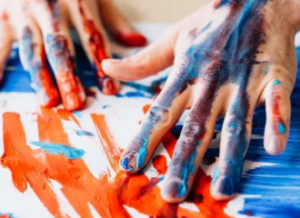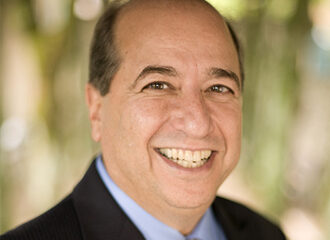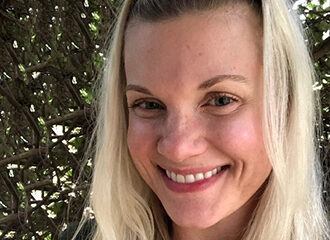Written By: Eleanor Poore, LMHC
Creative Arts Therapist at The Renfrew Center of Massachusetts

Whether exploring ambivalence and motivation to change, body image concerns, family dynamics, relationships with self or others, emotional expression, or cultural identity, sometimes we don’t have the words immediately, but we often feel it deeply (Hinz, 2006). This is where expressive arts can serve as a bridge to finding the words and will often surpass what we can express with words alone.
What are Examples of Expressive Art Therapy?
Our society often encourages us to only engage in activities we’re skilled at or generate income. Expressive arts therapies include visual art, music, dance/movement, and drama therapy.
To fully benefit from art therapy, one must approach it with an intention to connect to three things: courage, mindfulness, and a willingness to embrace imperfection. These intentions apply whether participating in a formal art group or individual session, or utilizing artistic expression as a means of coping, journaling, or processing on our own. Let’s go over this in more detail.
- Courage
“Creativity is a path for the brave, but it is not a path for the fearless, and it’s important to recognize the difference. Bravery means doing something scary. Fearlessness means not even understanding what the word scary means.” — Elizabeth Gilbert, Big Magic
What does courage have to do with art? It has everything to do with art, and everything to do with recovery. It takes great courage to let go of an eating disorder that was once providing such a necessary function. It can also be scary to put the first mark down on a blank page or to take risks when trying something new.
Accessing courage can open up so many doors to growth and change, and we never know what we will find through those doors. That may sound terrifying to some, so it takes courage to simply hope that change can be a positive thing. We can practice accessing this type of courage by creating art.
- Mindfulness
“Mindfulness is the awareness that arises from paying attention, on purpose, in the present moment, and non-judgmentally.” – Jon Kabat-Zinn.
Mindfulness is often used as a buzzword and we’re exposed to a lot of conflicting viewpoints and misconceptions about it. Something we hear frequently is, “I’m not good at mindfulness” and “mindfulness doesn’t work for me.” This is often coming from a place of focusing mostly on the outcome of meditation, not necessarily the practice of mindfulness.
Mindfulness and Meditation
Meditation is often used as a mindfulness tool, but it is just one way to go about doing it (Field, 2023). The intention of meditation is often perceived as a way to create a sense of calm, to slow down or even empty one’s mind of thoughts, and is typically practiced in physical stillness. It can be really helpful for some to try and eliminate sensory distractions while meditating, but that is not the only way that mindfulness can be practiced.
Mindfulness is a practice that can be integrated into both active and passive moments in our lives. When we engage in activities mindfully, we anchor ourselves in the intention of awareness, not with the goal of changing how we feel or what we think, but simply by tuning into the present moment. Naturally, sometimes the awareness that our minds are drifting into the past, future, or a place of judgment can sometimes change how we feel, but that is not the true goal. It can help us to notice when our thoughts are going in an unhelpful direction or we are subconsciously engaging in an unhelpful behavior, prompting us to anchor back into the present or actually make a choice to think more flexibly or behave differently. This could potentially lead to a change in how we are feeling in that moment, but that is not a necessary component of mindfulness. Mindfulness is a practice that isn’t tied to any specific outcome.
The Practice of Making Art
Art-making is also so much more about the practice than it is about the results. Sure, we may notice we enjoy creating art or feel proud of how an art piece turns out, but the therapeutic aspect of it lies in the process of creating it rather than judging what it looks like in the end. If we are too wrapped up in the end result, focusing on the future and worrying if it’s going to be good or bad, then we will miss out on several of the therapeutic benefits. Creating art provides an opportunity to tune into our emotions and ask them what they’re trying to tell us along the way.
Any talented artist is likely to have pages upon pages of “failed” pieces or practice pieces that are far from their final masterpiece. This process helps them to explore various options, refine their skills, or make low-risk mistakes before moving on to the final draft of a piece. We as humans cannot approach every aspect of life and every moment of creativity as if it is the final draft or with the expectation that it will be a masterpiece. If we do that, we can get really stuck in perfectionism and avoid creativity altogether, missing out on all the benefits that this process often provides.
- Willingness to be Imperfect
“Perfection manifests itself in three domains. Self-oriented perfectionism is imposing an unrealistic desire to be perfect on oneself. Other-oriented perfectionism means imposing unrealistic standards of perfection on others. Socially-prescribed perfectionism involves perceiving unrealistic expectations of perfection from others.” – Psychology Today
Perfectionism is a common challenge that surfaces in creative expression and the art therapy process. Things we’ve heard from multiple clients regarding perfectionism are, “I’m not good enough to be considered a perfectionist” or “I can’t be a perfectionist because I’m never actually perfect.” The thing is, perfectionism is so much more about the mindset that it is about the final product. According to the Miriam-Webster Dictionary, perfectionism is “a disposition to regard anything short of perfection as unacceptable especially: the setting of unrealistically demanding goals accompanied by a disposition to regard failure to achieve them as unacceptable and a sign of personal worthlessness.”
When there is so much pressure to be “successful”, to look a certain way, to be morally perfect, and so many seemingly competitive aspects of life, there’s no wonder why so many people fall into the trap of perfectionism. Being able to challenge perfectionism can be very scary, and we may have a hard time knowing where to start.
Letting Go of Expectations
In art therapy sessions, we often tell clients that in the worst case scenario, they will just create a piece of art they don’t like. If we can start to let go of expectations of what a piece is supposed to look like, the quality always being top tier, instead, we can make room for mistakes and “happy accidents” (as Bob Ross would say), and begin to grow in a different way than we originally expected. By testing the waters of breaking away from perfection in a non-threatening way, such as making “messy” or “ugly” art, we can then start to apply this to other aspects of life – slowly, but surely.
Conclusion
In summary, expressive arts therapy offers a powerful pathway for those navigating the complexities of eating disorder recovery. By embracing courage, mindfulness, and the willingness to be imperfect, individuals can unlock new dimensions of self-exploration and healing.
The act of creating art—whether through visual mediums, music, or movement—is a transformative process that fosters emotional expression and deeper understanding. It encourages participants to move beyond the constraints of perfectionism, allowing for personal growth and connection to their true selves. As we recognize the inherent value in the process of creation rather than just the outcome of it, we cultivate a more compassionate relationship with ourselves. In this way, expressive arts therapy not only facilitates recovery but also enriches our lives, inviting us to embrace the beauty of imperfection and the strength found in vulnerability.
Citations:
- Field, B. (2023, March 17). Mindfulness vs meditation: What’s the difference? Verywell Mind. https://www.verywellmind.com/mindfulness-vs-meditation-what-s-the-difference-6822721
- Gilbert, E. (2015). Big Magic. New York, New York: Riverhead Books.
- Hinz, L.D. (2006). Drawing from Within: Using Art to Treat Eating Disorders. London, UK and Philadelphia, PA: Jessica Kingsley Publishing.
- Kabat-Zinn, J. (1994). Wherever you go, there you are: Mindfulness meditation in everyday life. New York, NY: Hyperion.
- Merriam-Webster. (n.d.). Perfectionism definition & meaning. Merriam-Webster. https://www.merriam-webster.com/dictionary/perfectionism
- Sussex Publishers. (n.d.). Perfectionism. Psychology Today. https://www.psychologytoday.com/us/basics/perfectionism?msockid=391dcffa319c629c12ffdfc630b563f2



